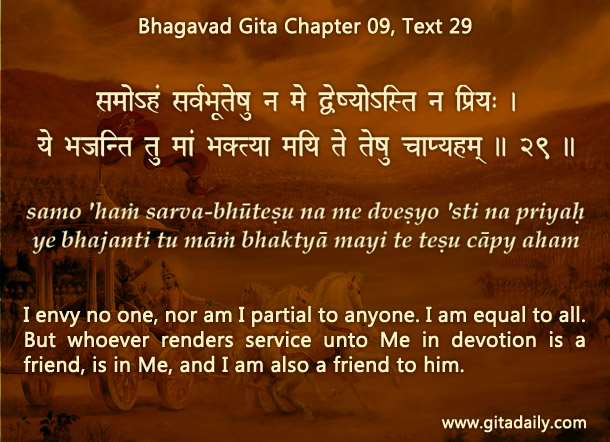
Some people say, “The Gita recommends bhakti as the path of the heart and jnana as the path of the head.”
But Gita wisdom doesn’t entertain such simplistic segregation; it integrates all our faculties in the spiritual quest. Towards its conclusion, the Bhagavad-gita (18.63) calls us to use our head to deliberate its message. Then (18.65, 18.66) it urges us to offer our heart to Krishna in devotional surrender. Thereafter (18.70) it commends those who use their head to study its message. And then (18.76,18.77), it depicts positively those who remember with a jubilant heart its message of intimacy and majesty. Thus, the Gita integrates both the head and the heart in its discourse of progressive spiritual evolution.
Another head-heart dichotomy is the notion that insight is the domain of the head and affection, the domain of the heart. But again the Gita breaks down such walls that attempt to divide our being into disparate domains. The Gita (10.08) indicates that insight produces affection – those who understand Krishna’s glory with their head thereafter serve him wholeheartedly. And two verses later it indicates (10.10) that affection produces insight – those who serve Krishna lovingly receive from him the intelligence to attain him.
The key to understanding the Gita symbiosis is to see it as a celebration of person-to-person reciprocation in the arena of transcendence. The Gita (09.29: mayi te teshu capy ‘ham) declares: “I live in my devotees and my devotees live in me”. Krishna is a living, loving person who loves us for who we are, his precious parts. And he sees us as persons who express our desire to love him by using in his service whatever we have – head or heart or both. Seeing the sincerity and intensity of our love, he reciprocates by offering eternal ecstatic life.
Explanation of article:



Hare Krishna Prabhuji! Please accept my humble obeisances! I’ve been reading your gita daily articles since last two months and they are inspiring me a lot. I’m connected with ISKCON, East Kailash, New Delhi. I’m currently in final year of my engineering in ECE course. Prabhuji! my point is sometimes i feel like i’m very much closer to Krishna and at other times due to my surrounding i feel frustrated and doubtful of myself. I want to prepare myself as an extensive preacher and i want to know in what way should i make a balance between my sadhana and studies? I’m studying Embedded Systems and preparing myself for this field to join a private company but then i feel as an engineer the products which we make are all based on concept of creating unnecessary wants in the market. How can i then devote my time and brain in studying these things while knowing that i’m also a part of the group who are running away from the reality and forcing people to think that technology is the only thing which can make you happy?
Answered here:
http://www.thespiritualscientist.com/2013/12/how-can-an-aspiring-devotee-precher-put-ones-heart-in-a-career-that-increases-peoples-illusions/
ys
ccdas
Nice explanation to this verse,
Sir, I always find easier and effective to control the head or mind through the heart, otherwise mind is very turbulent and chaotic and needs our heart and will power to control it, orelse i get lost somewhere. Heart is easy to control and more within one’s control and more satisfying to control too.
Answered here:
http://www.thespiritualscientist.com/2013/12/is-offering-the-heart-to-krishna-easier-and-more-fulfilling-than-offering-the-head/
ys
ccdas
Thank you prabhuji,
One who surrenders on to lotus feet of the Lord completely, beginning with the devotional service,tests the real nectar of bhaktiyoga.
Hare Krishna! Haribol!